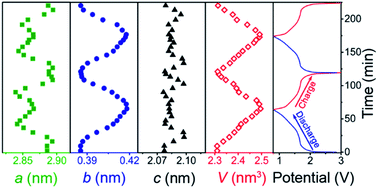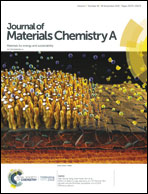Zinc niobate materials: crystal structures, energy-storage capabilities and working mechanisms†
Abstract
W5Nb16O55 is a very promising negative electrode compound for lithium-ion storage owing to its good safety, durable cyclability and high rate performance. However, its commercialization is hindered by its limited capacity and high tungsten cost. Here, we designed a tungsten-free and niobium-rich zinc niobate (Zn2Nb34O87) with a large capacity (theoretically 389 mA h g−1) as a new insertion negative electrode compound. Micron-sized Zn2Nb34O87 blocks (Zn2Nb34O87-B) and one-dimensional Zn2Nb34O87 nanofibers (Zn2Nb34O87-N) were prepared via a solid-state reaction and electrospinning methods, respectively. Zn2Nb34O87-B and Zn2Nb34O87-N have 3 × 4 × ∞ shear ReO3 crystal structures of orthorhombic and monoclinic types, respectively. Both the Zn2Nb34O87 materials exhibited better electrochemical performance than W5Nb16O55 in terms of the capacity, lithium-ion diffusion coefficient, intercalation pseudocapacitive contribution, rate performance, and cyclability. In situ X-ray diffraction characterization demonstrated the excellent structural stability and electrochemical reversibility of Zn2Nb34O87, and revealed that lithium ions were stored in the (010) crystallographic planes. Furthermore, a LiNi0.5Mn1.5O4‖Zn2Nb34O87-N full cell exhibited outstanding electrochemical performance, including a large capacity, prominent rate performance, and especially ultra-long cyclability (96.5% capacity retention even after 1000 cycles at 5C). Therefore, Zn2Nb34O87 holds great promise as a practical negative electrode compound for large-capacity, cost-effective, rapid, durable and safe lithium-ion storage.



 Please wait while we load your content...
Please wait while we load your content...